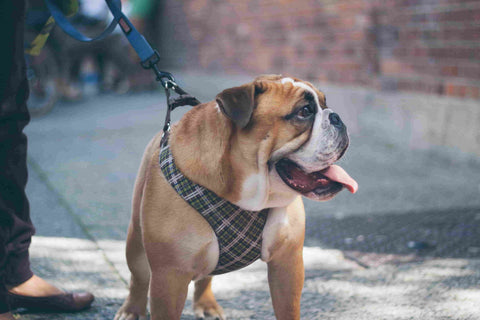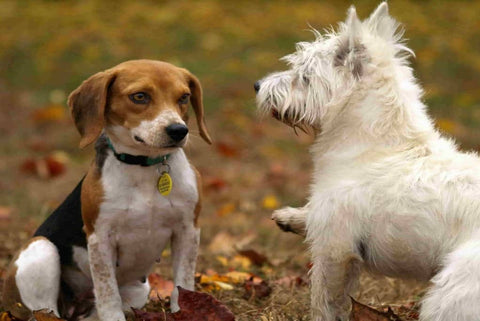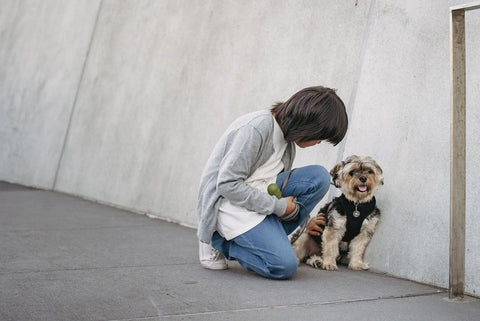What's the Best Harness for a Small Dog?
Having a small dog can be a joy as a pet parent, but you always want to mindful of its comfort and safety. A harness delivers both, but you have to make sure you get the perfect fit.
Taking the time to fit a harness properly for your small dog means you’re reducing the risk of injuries or escape, so both of you can enjoy the time you spend on walks.
Pet&Cuddle specializes in high-quality harnesses for dogs of all sizes, including small breeds.
Which Breeds Fit Small Dog Harnesses?
A small dog harness will usually fit if your pet has a chest girth ranging from 17 to 22 inches and a weight from 18 to 35 pounds. Don’t rely on weight alone when choosing a harness, however, because your dog’s weight may be distributed a little differently, so taking measurements gives you a better idea of what a good fit will be.
Below, we go into more detail about taking your small dog’s measurements before you shop for harnesses.
Breeds that often fit in a small harness include:
- Cavalier King Charles
- Pekingese
- Miniature Schnauzer
- Pug
- Scottish Terrier
You can find the full list of small dog breeds here.
How to Choose the Right Harness
There are three big factors that play a role in the harness you choose. These factors are your dog’s size, the type of harness, and how it fits. Let’s take a look at each of these elements so you can discover how to get the right one.
Select the Type
The types of dog harnesses you’ll have to choose from are:
- Back-Clip Dog Harness: With this type of harness, the clip that attaches to your leash is located on your dog’s back or the top of the harness. A back-clip harness is comfortable and provides a degree of freedom for your dog, but they’re best suited when your dog is trained on walking techniques.
- Step-in Dog Harness: A step-in harness is different from other types because it creates triangles at your dog’s legs. Other harnesses create rectangles. It’s a more comfortable fit, and it also makes it easier for you to put it on and take it off your dog. Typically, a step-in dog harness will have a clip at the back.
- Front-Clip Dog Harnesses: If your dog isn’t yet trained to walk properly or has an issue with pulling or lunging, consider a harness with a clip at the front of your dog’s chest. The design of a front-clip harness means that if your dog tries to pull, there’s tension between their shoulder blades. It works well as a training tool because your dog starts to learn to avoid that tension.
- Dual-Clip Dog Harness: Ideally, you should choose a dual-clip harness, and that’s what we highly recommend. A dual-clip harness has a leash clip at both the front and the top. This gives you versatility for training and walking in different environments. You can leash up to the front clip when you’re working on training. When your dog is ready, you can move to the top clip without having to replace your current harness.
Measure Your Dog to Get the Right Size
Once you decide on a general style, follow the steps below to determine the right size.
- Step One: Measure your dog’s neck. Use a measuring tape and loop it around the widest point of his neck. You should also measure from between your dog’s shoulder blades to the top of the chest to help you get an accurate number for the neck.
- Step Two: The next step is to measure your dog’s chest girth. You can measure your dog’s girth at the largest part of his body, right behind the front legs.
- Step Three: After you’ve measured your dog’s neck and chest, move on to his body length. Start measuring right behind the front leg, and then bring your tape measure to directly behind the rear leg.
Once you have these measurements, you can compare them to our Pet&Cuddle size chart. Choose the harness that matches your dog’s measurements. If your dog is between sizes or right on a cut-off measurement, size up. You can always adjust accordingly.
Achieve a Proper Fit
Once you get your new harness, put it on your dog for an initial fit test. You should be able to slip two fingers between the harness and your dog’s fur at any given point. This is a good rule of thumb for ensuring it’s neither too loose nor too tight.
Benefits of Using Harnesses for Small Dogs
Advantages of a harness for your small dog include:
- Control: Using harnesses offers you more control when you’re walking your dog. There are pressure points all around the body and additional attachment options, as compared to a collar. This control doesn’t come at the cost of comfort either. You’re not going to be pulling your dog’s neck or choking him with a harness.
- Training: It’s important for a dog to learn proper walking technique, how to heel, and also to not pull or lunge. Harnesses with a front clip are a good training tool.
- Safety: Because of how the pressure is distributed around a dog’s body, they’re not just more comfortable than a collar. As long as it’s the proper fit, it’s incredibly difficult to escape from a dog harness.
- Comfort: Small dogs would likely be overwhelmed and uncomfortable in a collar, whereas a harness allows for an easier adjustment.
Features to Consider for a Small Dog Harness
When choosing a harness for a small dog, look for the following features:
- Safe Design: All Pet&Cuddle harnesses are specifically designed to prioritize safety. You never want to put something around your dog’s neck that could potentially cause choking or injuries, which is one of the big advantages of a harness—the reduced risk of injury.
- Easy to use: Since you’re going to be using a harness every day and sometimes multiple times a day, you want to be able to quickly put it on and get your dog leashed up and ready to head out. You also don’t want to leave it on when you’re not on a walk, so it should be similarly easy to take off.
- Adjustable Belts: Even when you get precise measurements, you want that perfect, customized fit. Adjustable belts ensure that your dog is as comfortable as possible with the fit of his harness.
- Weight: You don’t want a clunky or cumbersome piece of equipment to take with you everywhere, so look for a lightweight harness that’s easily transported.
- Clip location: The clip location is the point where a leash attaches to your dog’s harness. A dual-clip harness is going to offer you the most versatility in how you use it, with a clip at the front and back.
- Reflective straps: Do you like going out for walks in the early morning or perhaps the evening? If so, stay safe with reflective straps.
- Material: Choose a material that’s soft and won’t cause injuries or irritation.
Can You Use an Extendable Leash with a Harness for Small Dogs?
As experts in leashes and harnesses, we often get the question of whether or not you can pair a retractable leash with a harness for small dogs. Yes, it is safe to use both a harness and a retractable leash together, with a few things in mind.
First, make sure that you’re always mindful when you’re walking your dog. No matter how safe your equipment, if you aren’t paying attention, it can be risky.
The next thing to remember is that you should give the leash line a little slack if you’re using it with a front-clip harness. That helps prevent any bad training technique from happening because your dog might think he’s pulling when he’s not. Otherwise, a retractable leash is a great option with a harness.
Should You Really Use a Harness for Little Dogs?
When you get the right harness, including one that fits well for your small dog, it will help you maximize your use of it and do so safely. If you’ve decided a harness is right for your dog, we encourage you to take measurements and buy one now. Our experts can help you choose a uniquely designed but also safe and comfortable dog harness as well.
We, the Pet&Cuddle dog lovers, are constantly creating new dog harness collections, which are safe, multifunctional, and effective for training, leading, or adapting purposes.
Discover the latest dog harness collection we created exactly for your dog here.
Questions About Using Harnesses with Small Dogs
Our goal at Pet&Cuddle is to pass on our knowledge and expertise as far as dog gear goes. With that in mind, we put together some of the most common questions we get about using harnesses with small dogs.
Are Harnesses More Secure for Small Dogs?
Harnesses are a more secure option for dogs of all sizes, including small dogs, compared to collars. With a collar, along with the discomfort and risk of injury, your dog can also slip out of them. This can actually be more true for a small dog. A harness alleviates that risk, so you aren’t constantly worried about an escape. Whether you’re walking, running, hiking or doing any activity, a harness can work well and provide a secure experience.
Are Harnesses Safer for Little Dogs?
There’s a real risk of using a collar around your dog’s neck. This is especially true for small dogs with vulnerable necks. With a dog harness, there’s less pressure at any one point on the body which reduces the risk of injury.
Are Harnesses More Comfortable for Small Dogs?
Harnesses are more comfortable for small dogs for the same reasons they’re safer. You’re taking that concentrated pressure that would come from using a collar and distributing it across their body, alleviating discomfort. You can still train your dog not to pull but without hurting him in the process.
What Age Can Dogs Start Using a Harness?
Since a dog harness is a valuable training tool, we recommend using one as soon as you can. The general guideline from veterinarians is to wait until your puppy is around eight months old to use a harness. Regardless of your dog’s age, getting the proper fit should be your priority.
When Should You Use a Harness?
Versatility is a benefit of using a harness, so you can use it any time you’re out and about with your dog. It’s well suited to a variety of scenarios, including training and walking. Whether you’re in a more open area or you’re walking in a congested place and need more control, a harness will be appropriate for the situation.
Do Harnesses Encourage Pulling?
There’s sometimes a fear that harnesses encourages pulling when the opposite is true in reality. There are no-pull dog harnesses that apply tension between your dog’s shoulder blades if he’s pulling. It doesn’t hurt him, but it helps him to learn how to walk properly. If your dog does tend to pull or isn’t well-trained in walking just yet, use the front clip of a harness, which is specifically what helps with training. Then, when your dog’s ready, you can use the top clip.
Get the Perfect Small Dog Harness from Pet&Cuddle
A small dog is well suited to a harness, as long as it fits well. Once you choose a good-fitting, comfortable and high-quality harness, it creates a walking routine that both of you ultimately look forward to. If you aren’t sure where to get started, we’re here to help, and it’s what we love to do.
We, at Pet&Cuddle, have processed all the knowledge and practical experiences to create the perfect harness with a unique design. Comfortable and safe, it now can be easily used for many purposes like training, walking, or adapting to a leash.
Discover the latest products for dogs available on our website!




